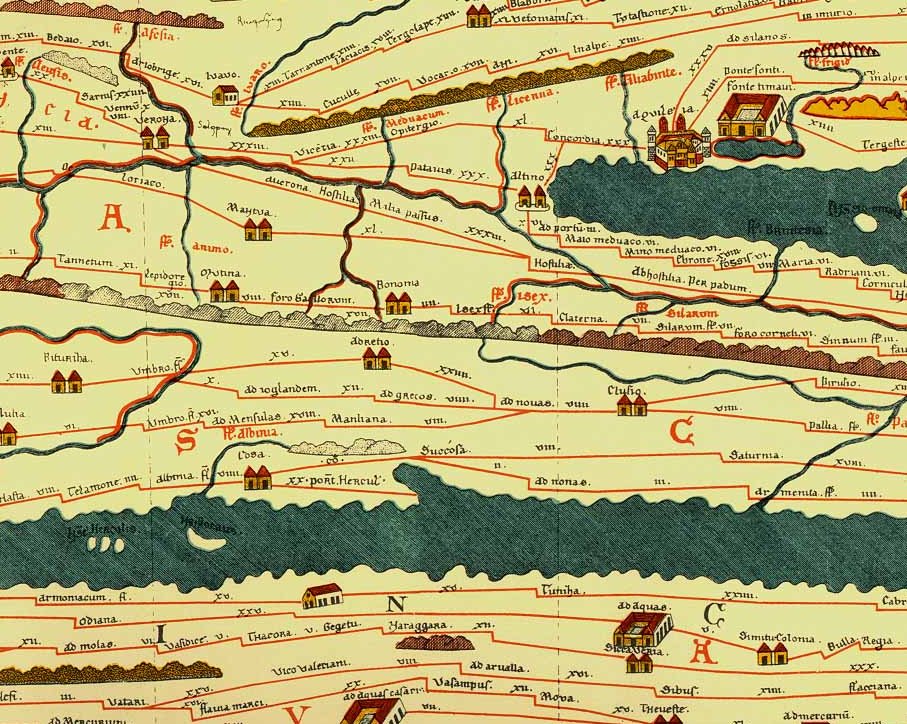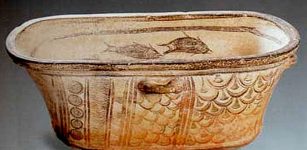Tabula Peutingeriana: Huge Ancient Roman Map Created By Unknown Cartographer
A. Sutherland - AncientPages.com - The Tabula Peutingeriana is a huge, six-meter-long parchment scroll depicting the Roman Empire's road network. It is an ancient, illustrated Roman road map and the only Roman world map that survived from antiquity.
The Tabula Peutingeriana has been used since at least the 18th century as a primary source for geography of the Roman Empire.
Tabula Peutingeriana (section)—top to bottom: Dalmatian coast, Adriatic Sea, southern Italy, Sicily, African Mediterranean coast. Image credit: Wikipedia
The map also known as “Peutinger Map” is a priceless artifact that has been dated to the twelfth or thirteenth century, but historians are convinced this is a copy of a much older original. The unknown cartographer used older sources, which date back to the first century.
A unique copy of the map is currently preserved at the National Library in Vienna. The map was discovered in a library in Worms by Conrad Celtes, who was unable to publish his find before his death and donated the map in 1508 to Konrad Peutinger, a German 15–16th-century humanist and antiquarian, after whom it is named.
It was passed around royal and elite families until it was bought by Prince Eugene of Savoy, and upon his death it was purchased by Vienna’s Austrian National Library where it has been kept since 1737.
According to one theory, the existing Tabula Peutingeriana is based on a document dated to the 4th or 5th century that contained a copy of the world map originally prepared by Marcus Vipsanius Agrippa, a Roman general, architect, and friend of Emperor Augustus (27 BC – AD 14).

Tabula Peutingeriana (section V - source
After Agrippa's death in 12 BC, that map was engraved in marble and placed in the Porticus Vipsania in the Campus Agrippae area in Rome, close to the Ara Pacis building.
However, Emily Albu, Professor Emerita of Classics University of Virginia, has suggested that the existing map could instead be based on an original from the Carolingian period that occurred from the late 8th century to the 9th century
Tabula Peutingeriana covers Europe (without the Iberian Peninsula and the British Isles), North Africa, and parts of Asia, including the Middle East, Persia, and India and the Ganges River, Sri Lanka (Insula Taprobane), even an indication of China.
The map also shows many Roman settlements, the roads connecting them, rivers, mountains, forests and seas. Three most important cities of the Roman Empire, Rome, Constantinople and Antioch, are represented with special iconic decoration.
The distances between the settlements showed on the map are also given and marked in Roman numerals indicating the miles or Gallic league (an ancient measurement, the original of the Old English mile).
Today this unique map is in very fragile condition. It was displayed to the public for a single day on November 26, 2007.
The full map with all details is shown - here.
Written by – A. Sutherland - AncientPages.com Senior Staff Writer
Updated on January 21, 2024
Copyright © AncientPages.com All rights reserved. This material may not be published, broadcast, rewritten or redistributed in whole or part without the express written permission of AncientPages.com
Expand for referencesReferences:
More From Ancient Pages
-
 Ancient Roman Altarpieces Deciphered And New Roman Goddess Uncovered In The Netherlands
Archaeology | Jun 18, 2024
Ancient Roman Altarpieces Deciphered And New Roman Goddess Uncovered In The Netherlands
Archaeology | Jun 18, 2024 -
 Unique Ornamented Golden Bronze Age Belt Discovered Near Opava, Czech Republic
Artifacts | Oct 28, 2022
Unique Ornamented Golden Bronze Age Belt Discovered Near Opava, Czech Republic
Artifacts | Oct 28, 2022 -
 On This Day In History: Mesoamerican Long Count Calendar Begins – On August 11, 3114 B.C
News | Aug 11, 2016
On This Day In History: Mesoamerican Long Count Calendar Begins – On August 11, 3114 B.C
News | Aug 11, 2016 -
 Origin Of The Genetic Code – Study
DNA | Dec 16, 2024
Origin Of The Genetic Code – Study
DNA | Dec 16, 2024 -
 Mysterious Bronze Age Viksö Helmets With Horns Related To Myths, Holy Animals And Divine Power
Artifacts | Feb 27, 2018
Mysterious Bronze Age Viksö Helmets With Horns Related To Myths, Holy Animals And Divine Power
Artifacts | Feb 27, 2018 -
 Ogham: Unique Celtic Alphabet Used By Druids And Abandoned During Christian Era
Featured Stories | Jul 9, 2021
Ogham: Unique Celtic Alphabet Used By Druids And Abandoned During Christian Era
Featured Stories | Jul 9, 2021 -
 Astronomically Aligned Pyramidal Buildings Of America’s Oldest City Reveal How Its Builders Apprehended Space And Time
Archaeology | Apr 15, 2021
Astronomically Aligned Pyramidal Buildings Of America’s Oldest City Reveal How Its Builders Apprehended Space And Time
Archaeology | Apr 15, 2021 -
 Viking Era Sword Discovered By Young Girl
Archaeology | Oct 5, 2018
Viking Era Sword Discovered By Young Girl
Archaeology | Oct 5, 2018 -
 Study Of Ancient Skulls Sheds Light On Human Interbreeding With Neandertals
Archaeology | Aug 23, 2022
Study Of Ancient Skulls Sheds Light On Human Interbreeding With Neandertals
Archaeology | Aug 23, 2022 -
 DNA Analysis Of Human Remains In Early Medieval Alemannic Graveyard
Archaeology | Sep 6, 2018
DNA Analysis Of Human Remains In Early Medieval Alemannic Graveyard
Archaeology | Sep 6, 2018 -
 Ancient Goldsmith’s Toolkit Discovered Near Stonehenge
Archaeology | Dec 16, 2022
Ancient Goldsmith’s Toolkit Discovered Near Stonehenge
Archaeology | Dec 16, 2022 -
 More Beautiful Mosaics In The Ancient City Of Hadrianopolis In Northern Turkey
Archaeology | Sep 28, 2022
More Beautiful Mosaics In The Ancient City Of Hadrianopolis In Northern Turkey
Archaeology | Sep 28, 2022 -
 12,000-Year-Old Ice Age Stone Tools Found – Earliest Dated Evidence For Human Activity in Scotland
Archaeology | Oct 10, 2015
12,000-Year-Old Ice Age Stone Tools Found – Earliest Dated Evidence For Human Activity in Scotland
Archaeology | Oct 10, 2015 -
 10 Ancient Shipwrecks And Several Underwater Artifacts Found Around The Island Of Kasos
Archaeology | Mar 14, 2024
10 Ancient Shipwrecks And Several Underwater Artifacts Found Around The Island Of Kasos
Archaeology | Mar 14, 2024 -
 Ireland’s Population Was In Decline When Vikings Arrived To Settle
Archaeology | Aug 22, 2019
Ireland’s Population Was In Decline When Vikings Arrived To Settle
Archaeology | Aug 22, 2019 -
 Was Hygiene Important For Our Ancestors?
Featured Stories | Feb 11, 2017
Was Hygiene Important For Our Ancestors?
Featured Stories | Feb 11, 2017 -
 Ancient Maya Ballcourts And Evidence Of Ceremonial Plant Species Offerings
Ancient Traditions And Customs | Apr 29, 2024
Ancient Maya Ballcourts And Evidence Of Ceremonial Plant Species Offerings
Ancient Traditions And Customs | Apr 29, 2024 -
 Priceless Artifacts From The Bactrian Hoard Are Missing – Where Are They?
Artifacts | Apr 3, 2022
Priceless Artifacts From The Bactrian Hoard Are Missing – Where Are They?
Artifacts | Apr 3, 2022 -
 Riddle Of The Ancient Lost City Beneath Missouri – A Puzzling Discovery
Civilizations | Mar 21, 2022
Riddle Of The Ancient Lost City Beneath Missouri – A Puzzling Discovery
Civilizations | Mar 21, 2022 -
 Amazing Margate Shell Grotto – Kent’s Greatest Mystery
Featured Stories | Jun 10, 2014
Amazing Margate Shell Grotto – Kent’s Greatest Mystery
Featured Stories | Jun 10, 2014

